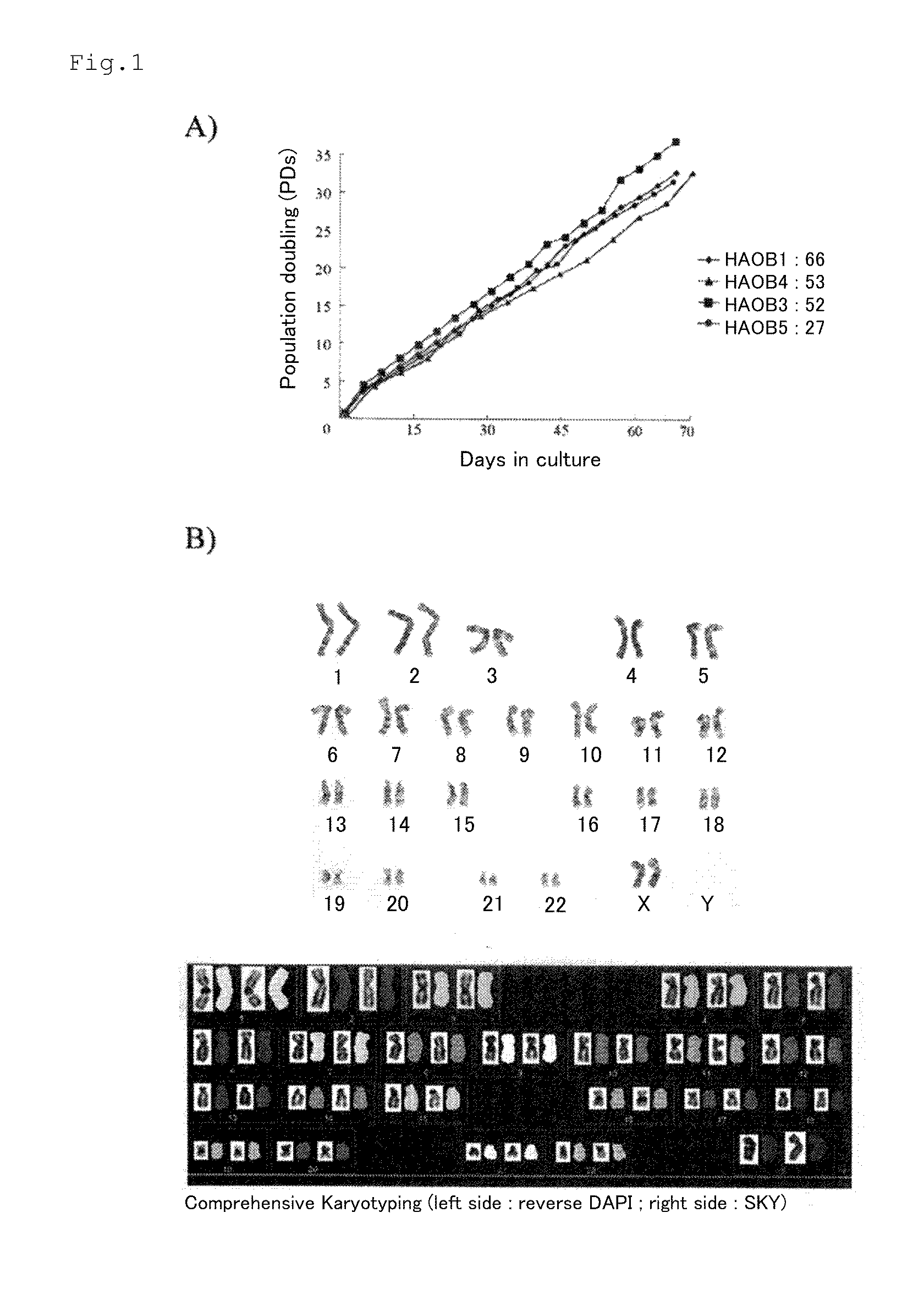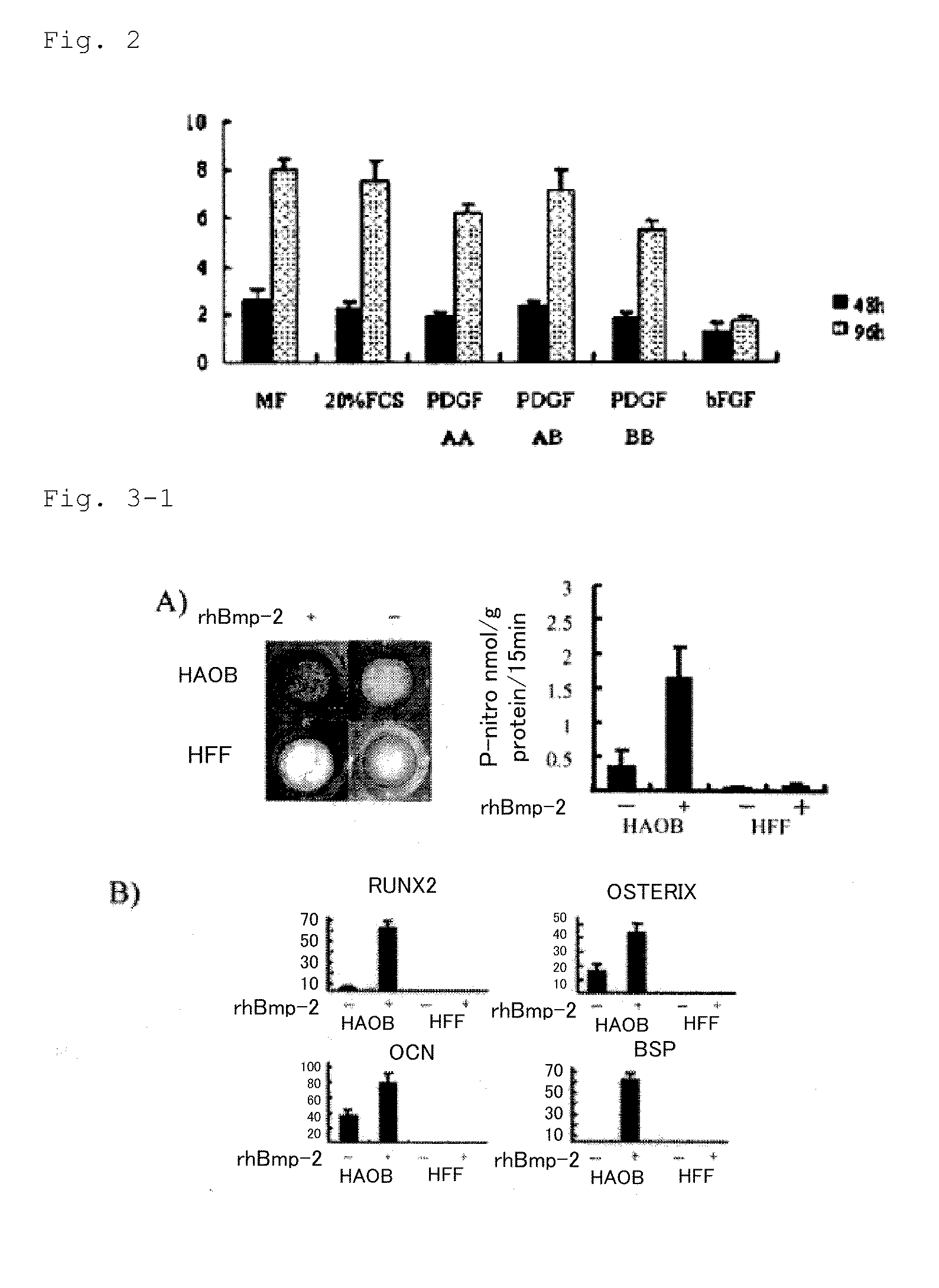Cell preparation for bone tissue regeneration
a cell preparation and bone tissue technology, applied in the field of cell preparation, can solve the problems of bone tissue not recovering to its normal state, teeth loss, and long recovery time, and achieve the effects of less demanding patients, effective treatment of periodontal disease, and high clinical us
- Summary
- Abstract
- Description
- Claims
- Application Information
AI Technical Summary
Benefits of technology
Problems solved by technology
Method used
Image
Examples
example 1
Preparation of Alveolar Bone-Derived Undifferentiated Osteoblasts
[0080]Alveolar bone-derived undifferentiated osteoblasts were prepared using the alveolar bone removed during the course of tooth extraction from four patients (age 66, 53, 52, and 27), who gave informed consent based on the resolution of the ethics committee. The alveolar bone was subjected to an enzyme reaction at 37° C. for 20 min in 4-ml PBS (Phosphate buffered saline, pH 7.2) that contained 2 mg / ml of bacteria-derived collagenase (>1.5 U / mg; Collagenase P, Roche). After the reaction, the bone was centrifuged with addition of an enzyme liquid and an equal amount of bovine serum to collect free cells, and the remaining alveolar bone was subjected again to enzyme treatment under the same conditions. This procedure was repeated, and a total of eight enzyme treatments were performed. Of the eight cell fractions collected after these enzyme treatments, the cell fractions collected after the first and second enzyme treat...
example 2
Proliferative Capacity Evaluation of Alveolar Bone-Derived Undifferentiated Osteoblasts
[0081]The HAOBs obtained in Example 1 were inoculated in MF medium (Toyobo Co., Ltd., Tokyo, Japan) at a concentration of 3×104 cells / ml, and the cells were subcultured for 70 days with the medium replaced every 3 days. The population doubling (PD) of HAOBs during the course of cell growth was measured.
[0082]HAOB3 at PD 35 was treated with Colcemid (Karyo Max; Gibco BRL; 100 ng / ml for 6 h) and induced to enter interphase. The chromosome structure of the HAOB3 (about 50 cells) induced to enter interphase was then analyzed using a G-band method. The chromosome structure of the HAOB3 induced to enter interphase was also analyzed using a SKY (Spectral Karyotyping) method.
[0083]The results are presented in FIG. 1. It was confirmed from these results that the HAOBs (HAOB1 to 3) obtained from the alveolar bones of the middle-aged and elderly individuals had growth rates comparable to that of the HAOBs (H...
example 3
Proliferation Characteristic Evaluation of Alveolar Bone-Derived Undifferentiated Osteoblasts
[0084]The HAOB3 obtained in Example 1 was inoculated in a 96-well plate at a concentration of 2×104 cells / well, and cultured in serum-free Dulbecco's modified Eagle's medium (DMEM) for 24 hours. The cells were further cultured for 96 hours in DMEM medium supplemented with 10 ng / ml bFGF, PDGFAA, PDGFAB, or PDGFBB, and cell proliferation activity was evaluated. As a control, the HAOB3 cultured in DMEM medium was cultured for 96 hours in serum-free or 20 volume % FCS-containing DMEM or in MF medium in the same manner, and cell proliferation activity was evaluated. Note that cell proliferation activity was measured using Celltiter-Glo luminescent cell viability assay (Promega) according to the manufacturer's protocol.
[0085]The results are presented in FIG. 2. The vertical axis in FIG. 2 represents the calculated value of cell proliferation activity relative to the value 1 assigned to the number ...
PUM
 Login to view more
Login to view more Abstract
Description
Claims
Application Information
 Login to view more
Login to view more - R&D Engineer
- R&D Manager
- IP Professional
- Industry Leading Data Capabilities
- Powerful AI technology
- Patent DNA Extraction
Browse by: Latest US Patents, China's latest patents, Technical Efficacy Thesaurus, Application Domain, Technology Topic.
© 2024 PatSnap. All rights reserved.Legal|Privacy policy|Modern Slavery Act Transparency Statement|Sitemap



